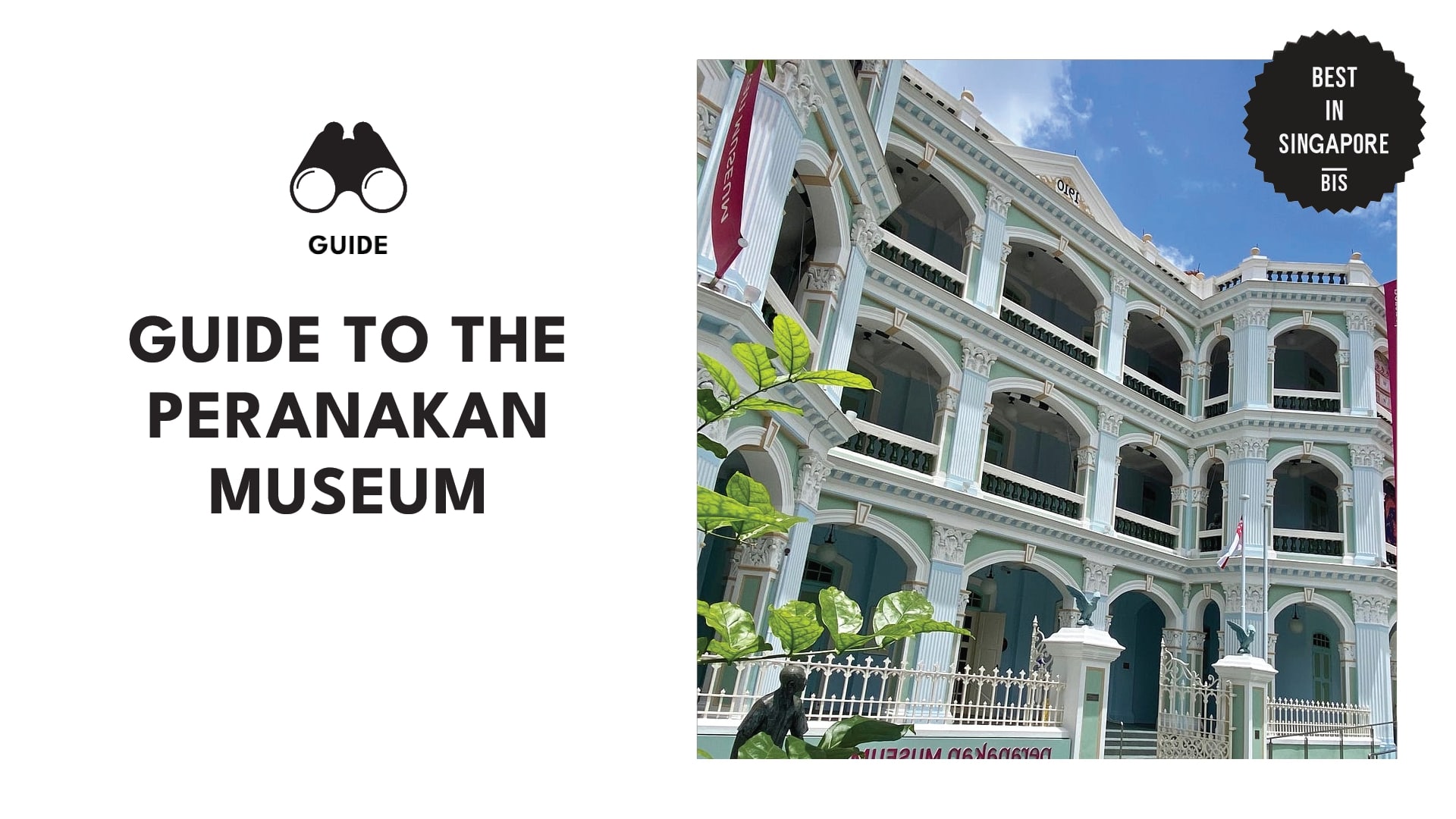A Guide to the Singapore Peranakan Museum: Exploring the Rich Heritage of Peranakan Culture
Singapore is home to many ethnic enclaves, and one that’s thriving here is the Peranakan community. I believe in nurturing bonds with your neighbours, so I visited the Peranakan Museum to get to know their rich heritage better!
This museum is a trove of all things Peranakan. Not only did I learn about the history of Peranakan culture in Southeast Asia, but I also discovered how influential it is to Singaporean society—from the colourful tiles to the tasty cuisine.
If you want to learn more about this culture, feel free to use this guide to the museum!
Things to Know
Address: 39 Armenian St, Old Tao Nan School
Operating Hours:
- Saturday to Thursday—10 am to 7 pm
- Sunday—10 am to 9 pm
Contact Number: +6563327591
Website
How to Get There
By MRT: Take any train line that stops at any of the following train stations: City Hall, Bras Basah, or Bencoolen. From any of these stations, you can walk to the museum, which should take about 10 minutes.
By Bus: Ride any of the following bus services: 2, 12, 12e, 32, 33, 51, 61, 63, 80, 197, or 640E. Then, stop at bus stop 04142, which is right by the Armenian Apostolic Church. From there, walk to the museum, which is about five minutes.
By Car: There’s no dedicated parking lot here. But there are parking spaces nearby, such as the ones at the NTUC Income Center, Funan, Excelsior, and Peninsula Plaza.
Admission Fees
Here are the current prices for admission at the museum.
Please keep in mind that all tickets aren’t refundable. You also can’t sell or exchange them.
Museum Etiquette
To ensure a seamless experience, be sure to follow the museum etiquette. Here are the rules you must keep in mind:
- Please maintain silence inside the museum. If you want to talk, keep your voice low.
- Please don’t touch any items on display. These artefacts are really old, and even the oil from your fingers is enough to damage them.
- No outside food and drinks are allowed inside the museum. You’re also not allowed to bring large backpacks, trolleys, and other bulky items.
- Photography and videography are allowed inside, but make sure not to use the flash.
- Please keep in mind that your photos and videos are only for personal use—not commercial.
Galleries to Check Out
Origins
From: peranakanmuseum
Located on the first level, Origins is the first gallery you’ll come across. This gallery answers the question “What is Peranakan?”
Throughout the gallery, you’ll come across video interviews where Peranakan respondents answer that question and what the culture means to them. These videos are quite insightful, so I always take the moment to watch them every time I visit.
Additionally, this gallery features a brief history of trade and migration history of Peranakans. There are even displays of artefacts that have been traded throughout the years. Most are textiles, but there are also old books and ornate earthenware.
Ceramics and Food Culture
From: peranakanmuseum
Food is incredibly important in Peranakan culture, so it makes sense that the museum has a separate gallery dedicated to it. In the Ceramics and Food Culture gallery, you’ll find several videos related to Peranakan food and an installation of tok panjang, a traditional long dining table with several dining wares.
My favourite part of the gallery is the display of the Peranakan ceramics, also known as Nyonya ware. They’re basically works of art; I can’t stop looking at them!
Family and Community Life
From: peranakanmuseum
The second level of the museum explores the theme of home. The gallery named Family and Community Life focuses on the different Peranakan homes. You can see these houses in photos—from attap houses in kampongs to shophouses and villas of the past.
This gallery houses different furniture items as well. Wardrobes with mirrors, dressing tables, work desks, and more—you name it, this gallery has it. There’s even a Peranakan-style carriage here!
Fashion
From: peranakanmuseum
As someone who loves fashion, I have to say that Level 3 is my favourite because it has all the fashion-related galleries. One such gallery you can find is the aptly named Fashion.
This gallery makes me forget that I’m in a museum. I feel like I’m in a boutique, what with the grand displays of colourful Peranakan shirts, skirts, and dresses on mannequins.
Womenswear and menswear clothes aren’t the only items you’ll find here. There are also shoes, bags, and accessories, and all of them are just as vibrant and beautiful.
Batik
From: peranakanmuseum
Batik is one of the signature dyeing techniques of Peranakan clothing, and if you want to know more about it, you better head off to the Batik gallery! Here, you’ll get to learn about its history—how it managed to spread from humble towns in Java to countries all over the world.
What I find fascinating about batik is its various designs and motifs. I can just imagine the dedication and patience it took to create these!
Decorative Textiles
From: peranakanmuseum
Peranakan textile arts don’t just stop with clothes. They also have decorative textiles that are just as eye-catching and brightly coloured, and you can see some of them at the Decorative Textiles gallery!
These decorative textiles are so impressive! They’re done through needlework, a painstaking and time-consuming process. How can I not be in awe?
The array of textiles here is also pretty varied. There are house items like slippers and bed curtains, and there are extravagant textiles that are used for major celebrations like weddings.
Jewellery
From: peranakanmuseum
Complete your exploration of Peranakan fashion by heading to the Jewellery gallery. Here, you’ll find a glistening array of more than 180 pieces of jewellery, all from different stages of life and occasions.
Some of my favourite heirlooms here have to be the Arab Peranakan hairpin and the Chitty Melakan addigai necklace.
Other Things to Do
Attend a fun exhibition
From: peranakanmuseum
In addition to the permanent galleries, the museum also hosts fun exhibitions regularly.
The last exhibition I attended was called Batik Nonyas, which tackled the art and entrepreneurship of three batik innovators: Nyonya Oeij Soen King, Nyonya Oeij Kok Sing, and Jane Hendromartono.
These three women actually came from the same family, and I found it fascinating how the descendants kept the tradition and also added their own flair. The dye patterns shown during the exhibition were so pretty, I thought they were watercolour paintings!
Join a guided tour
From: peranakanmuseum
I love exploring museums all by myself, but sometimes, I want the company of a knowledgeable guide. That’s why I sometimes go on guided tours, and I recommend you do the same. It’s free!
The tour is conducted by a volunteer docent who will walk you through the different displays of each gallery.
Participate in the Singapore Night Festival
From: sgnightfest
The Singapore Night Festival is one of the most exciting festivals in the country, and fortunately, the Peranakan Museum is one of the locations participating!
The theme for this festival changes every year, but the gist is that you’ll be going on a thrilling adventure in the dark. From my past experiences, I tried roller-skating and admiring a project mapping installation inside the Peranakan Museum.
There are also stalls and kiosks propped up outside the museum selling all sorts of delectable street food. The whole night is just so much fun!
Immerse yourself in the Armenian Street Party: Peranakan Pasar
From: peranakanmuseum
Another festival or celebration that the museum participates in is the Armenian Street Party. Just like the Night Festival, this street party is only active at night, and it specifically celebrates the very best of Peranakan cuisine.
The street is lined with stalls selling Peranakan food of all kinds—from the classics to the ones with modern twists. I love chendol, an iced sweet dessert topped with jellies, coconut milk, and palm sugar syrup. It’s so delectable!
Sometimes, there will also be vendors selling Peranakan-themed cookbooks. Look out for them if you want to try cooking some of the dishes at home!
Become a volunteer
From: peranakanmuseum
If you’re passionate about Peranakan culture or want an exciting experience to add to your resume, you might want to volunteer at this museum.
Before you become a docent at the museum, you’ll have to undergo training and self-study. You might even have the chance to go on a field trip! Once you’ve completed everything, you’ll be ready to conduct guided tours.
Host an event
From: peranakanmuseum
Planning a birthday party or a corporate get-together? You might want to consider hosting it here!
The Peranakan Museum’s main event space is the Ixora Room, which can hold up to 70 people. It’s equipped with a basic sound system, projector, and screen, so it’s possible to conduct exciting activities here.
If you have any questions, contact Yanie Tan via email ([email protected]) or phone (+6569821390 or +6569821302).


